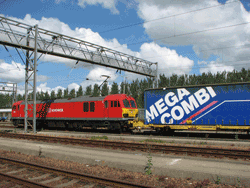DB Schenker Rail operates first European sized freight train over High Speed 1
Posted: 27 July 2011 | | 1 comment
The project to introduce regular European sized freight trains on High Speed 1 has achieved a major breakthrough…


The project to introduce regular European sized freight trains on High Speed 1 has achieved a major breakthrough following the successful operation by DB Schenker Rail during the early hours of Saturday 23 July 2011 of the first European sized freight train on the route.


Two wagons from Spanish logistics operator Transfesa, part of DB Schenker Rail, and four European sized swap bodies were successfully transported over High Speed 1 on Saturday 23 July from Dollands Moor near Folkestone to a rail terminal in East London in a fault free operation. This has clearly demonstrated that European sized rail freight can be transported efficiently from across mainland Europe to London.
DB Schenker Rail plans to follow this initial operation with the first full train of European sized swap bodies, with regular services being introduced thereafter.
In doing so, DB Schenker Rail will connect the UK via the High Speed 1 route to the rest of its pan European rail freight network, opening a new market for customers to export and import goods more efficiently using larger wagons.
Alain Thauvette, Chief Executive of DB Schenker Rail (UK) Ltd, said: “This rail freight service is a historic milestone for European rail freight. For the first time ever, the larger swap bodies as used as standard across mainland Europe were transported to London in a fault free operation. The UK is now connected to the larger freight railway used across Europe.”
Mr Thauvette continued: “We have been conducting trials over five months on the High Speed 1 rail route, arriving at this major milestone. We will now deliver larger freight trains travelling from anywhere across Europe on the DB Schenker Rail pan-European network to London. This will increase modal shift between road to rail across Europe.”
Bernd Hullerum, Chief Executive of Transfesa, said: “This is a great opportunity for our automotive customers to link their European plants using the same Mega Combi equipment used for this trial, as they offer the possibility to load up to 96 cubic meters in a curtain sided unit which is key for this industry.”
The work to introduce rail freight services onto High Speed 1 has been supported by the European Commission’s Marco Polo programme.



The next stage is now re-open and electrify the Great Central railway to the North. This line was built to Continental gauge so should easily be used for these trains and not just stop in the South. There is life beyond London.